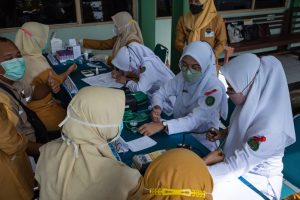Did you know that over half of people with diabetes (57%) in Southeast Asia are undiagnosed? Many people who suffer from diabetes are not even aware that they have the condition. Diabetes, if left untreated, can lead to a slew of health complications like heart disease and nerve damage. Hence, it is important to be aware of the warning signs. Keep reading to find out more about the criteria for a diabetes diagnosis, and how to monitor diabetes mellitus.
Diagnosis of diabetes
To diagnose diabetes, doctors typically utilise the fasting plasma glucose (FPG) test or the A1C test. They may utilise a random plasma glucose (RPG) test in some circumstances.
Fasting plasma glucose test
The fasting plasma glucose (FPG) blood test detects the level of glucose in your blood at a specific moment in time. It is advisable to have this test in the morning, after you have fasted for at least 8 hours, for the most accurate results. Fasting entails not eating or drinking anything other than sips of water.
Oral glucose tolerance test (OGTT)
The oral glucose tolerance test (OGTT) assesses blood glucose levels after a fast of at least 8 hours. First, a medical practitioner will take your blood. Then, you will consume a beverage containing glucose. Your medical practitioner will draw your blood 2 hours after consumption to diagnose type 2 diabetes and pre-diabetes. The OGTT is more effective than the FPG test in detecting type 2 diabetes and prediabetes, but it is also a more expensive test that is more difficult to administer.
A1C test
The A1C test is a blood test that measures your average blood glucose levels over the previous three months. The A1C test is also known as the haemoglobin A1C, HbA1C, glycated haemoglobin, and glycosylated haemoglobin test. You may eat and drink prior to the exam. When utilising the A1C test to diagnose diabetes, your doctor will take into account factors such as your age and if you have anaemia or other blood issues. This test is not as accurate for anaemia sufferers.
Your A1C test results may be artificially high or low if you are of Mediterranean or Southeast Asian origin. Your physician may need to request a different type of A1C test. Your A1C test result will be reported as a percentage, such as A1C of 7%. The greater the percentage, the higher your average blood glucose levels. The result may also be reported as estimated average glucose (eaG).
Make sure to go for an A1C test at least twice a year.
Random plasma glucose test
When diabetes symptoms are evident and healthcare practitioners do not want to wait until you have fasted, they may perform the random plasma glucose (RPG) test to diagnose diabetes. The RPG test does not need you to fast overnight, and you can take it at any time.
What do the test numbers mean?
Here is a summary to help you understand what your test numbers mean if you are not pregnant:
| Diagnosis | A1C (percent) | Fasting plasma glucose (FPG) | Oral glucose tolerance test (OGTT) | Random plasma glucose test (RPG) |
| Normal | below 5.7 | 99 or below | 139 or below | |
| Pre-diabetes | 5.7 to 6.4 | 100 to 125 | 140 to 199 | |
| Diabetes | 6.5 or above | 126 or above | 200 or above | 200 or above |
*Glucose values are in milligrams per decilitre, or mg/dL.
*OGTT test values are at 2 hours after drinking 75 grams of glucose. To diagnose gestational diabetes, doctors give women more glucose to consume and use different numbers as cutoffs.
How do I monitor for my diabetes?
The most important thing you can do to manage type 1 or type 2 diabetes is to monitor your blood sugar levels on a regular basis. You’ll be able to observe what causes your numbers to rise or fall, such as eating different foods, taking your medication, or exercising. With this information, you can collaborate with your healthcare team to determine the optimal diabetes care strategy for you.
Diabetes complications such as heart attack, stroke, renal disease, blindness, and amputation can be delayed or avoided completely with careful monitoring. Your doctor will advise you on when and how frequently you should monitor your blood sugar levels. Most blood sugar meters allow you to save your readings so you can track them with an app on your phone.
A portable electronic device known as a blood sugar meter can be used to test your blood sugar at home using a small drop of your blood. A continuous glucose monitor (CGM) is another device that can be used.
How frequent should I monitor?
The frequency of testing is usually determined by the type of diabetes and the treatment strategy. If you have type 1 diabetes, your doctor may recommend blood sugar testing four to 10 times a day, usually before meals, or before and after exercise.
If you use insulin to manage type 2 diabetes, your doctor may advise you to test your blood sugar multiple times a day, depending on the type and amount of insulin you use. If you take many daily injections, testing is usually done before meals and after bedtime. If you only use intermediate- or long-acting insulin, you may only need to test before breakfast and dinner.
You may not need to test your blood sugar on a daily basis if you manage type 2 diabetes with non insulin drugs or diet and exercise alone.
Complications of diabetes
Diabetes mellitus is a condition that develops when your blood glucose, often known as blood sugar, is abnormally high. There are two common types of diabetes – type 1 and 2. With type 1 diabetes, your body does not produce insulin, while with type 2 diabetes, your body does not produce or utilise insulin well. Without enough insulin, glucose stays in your blood.
If you have diabetes, you should be aware of blood sugar levels that are extremely high (hyperglycaemia) or extremely low (hypoglycaemia). These things can happen quickly and become deadly.
Having too much glucose in your blood can lead to health issues such as heart disease, neurological damage, eye problems, and kidney disease over time. Here are just some of the health problems that diabetes can cause if left untreated:
- Eye disease – caused by changes in fluid levels, tissue swelling, and damage to the blood vessels in the eyes.
- Foot problems – caused by nerve damage and decreased blood supply to your foot.
- Gum disease and other dental disorders – caused by a high level of blood sugar in your saliva, which promotes the growth of harmful bacteria in your mouth. Plaque is formed when bacteria interacts with food to form a soft, sticky coating. Plaque can also be caused by eating foods high in sugars or carbohydrates. Plaque can cause gum disease, bad breath, tooth decay, and cavities.
- Heart disease – caused by damage to your blood vessels and the nerves that control your heart and blood vessels.
- Kidney disease – caused by blood vessel damage in the kidneys. High blood pressure is a common complication of diabetes. This can also harm your kidneys.
- Nerve disorders (diabetic neuropathy) – caused by damage to the nerves and the small blood vessels that supply oxygen and nutrients to your nerves.
- Sexual and bladder issues – caused by nerve injury and decreased blood flow in the genitals and bladder.
- Skin diseases – caused by alterations in the tiny blood vessels and decreased circulation. Diabetes patients are also more likely to get infections, particularly skin infections.
Conclusion
The goal of diabetes treatment is to keep blood sugar levels under control. Monitoring your blood sugar is the only way to know if you’re on track. Ultimately, blood sugar monitoring is essential in the treatment of diabetes. Stay tuned for our next article on the different types of treatments for diabetes.












